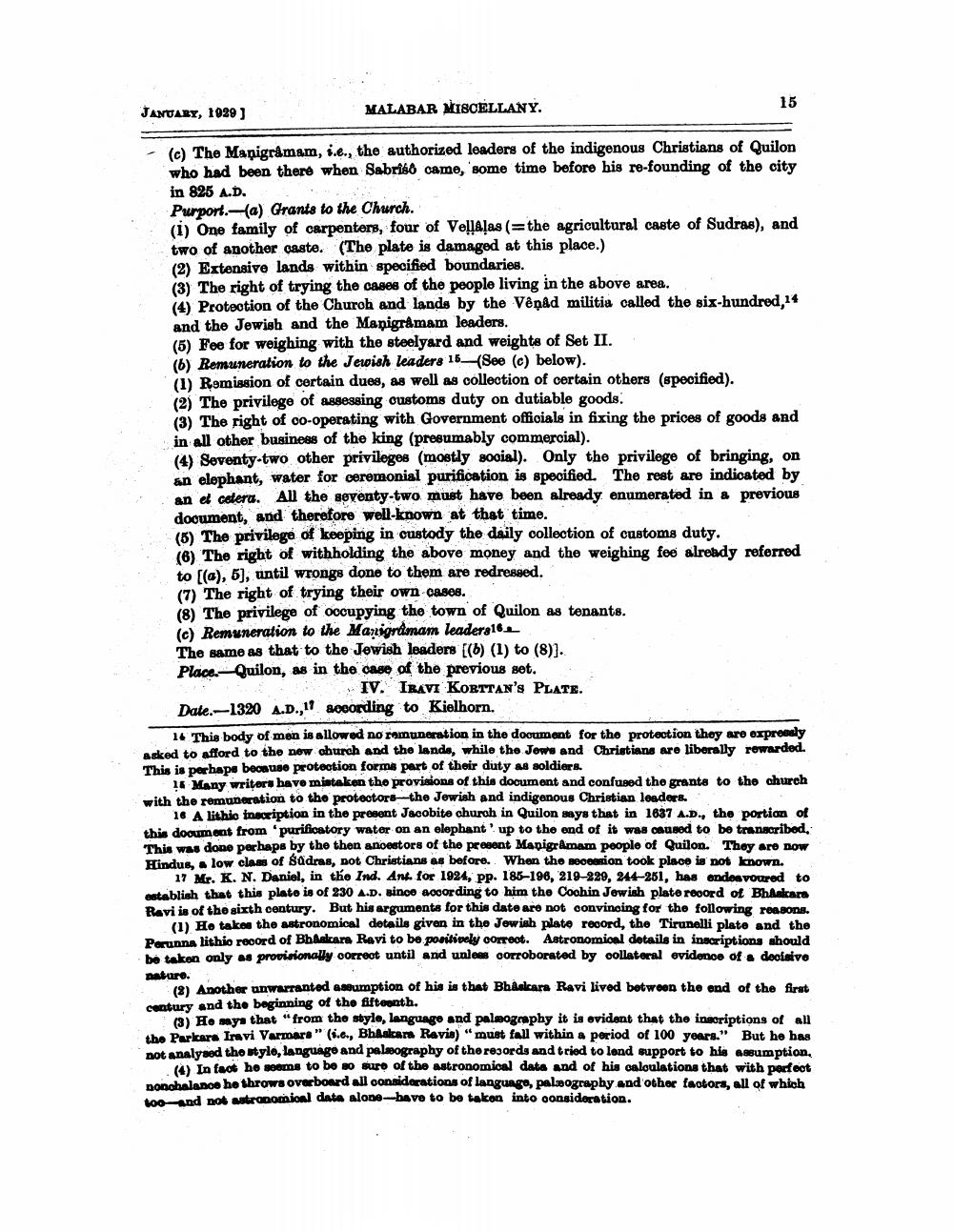________________
JANUARY, 1929]
MALABAR MISCELLANY.
(c) The Manigramam, i.e., the authorized leaders of the indigenous Christians of Quilon who had been there when Sabriso came, some time before his re-founding of the city in 825 A.D.
15
Purport.-(a) Grants to the Church.
(1) One family of carpenters, four of Vellalas (the agricultural caste of Sudras), and two of another caste. (The plate is damaged at this place.)
(2) Extensive lands within specified boundaries.
(3) The right of trying the cases of the people living in the above area.
(4) Protection of the Church and lands by the Vênâd militia called the six-hundred,14 and the Jewish and the Manigramam leaders.
(5) Fee for weighing with the steelyard and weights of Set II.
(b) Remuneration to the Jewish leaders 15-(See (c) below).
(1) Remission of certain dues, as well as collection of certain others (specified).
(2) The privilege of assessing customs duty on dutiable goods.
(3) The right of co-operating with Government officials in fixing the prices of goods and
in all other business of the king (presumably commercial).
(4) Seventy-two other privileges (mostly social). Only the privilege of bringing, on an elephant, water for ceremonial purification is specified. The rest are indicated by an et cetera. All the seventy-two must have been already enumerated in a previous document, and therefore well-known at that time.
(5) The privilege of keeping in custody the daily collection of customs duty.
(6) The right of withholding the above money and the weighing fee already referred to [(a), 5], until wrongs done to them are redressed.
(7) The right of trying their own cases.
(8) The privilege of occupying the town of Quilon as tenants.
(c) Remuneration to the Manigramam leaders16
The same as that to the Jewish leaders [(b) (1) to (8)].
Place. Quilon, as in the case of the previous set.
IV. IBAVI KOETTAN'S PLATE. Date.-1320 A.D.,17 according to Kielhorn.
14 This body of men is allowed no remuneration in the document for the protection they are expressly asked to afford to the new church and the lands, while the Jews and Christians are liberally rewarded. This is perhaps because protection forms part of their duty as soldiers.
18 Many writers have mistaken the provisions of this document and confused the grants to the church with the remuneration to the protectors the Jewish and indigenous Christian leaders.
16 A lithic inscription in the present Jacobite church in Quilon says that in 1637 A.D., the portion of this document from 'purificatory water on an elephant up to the end of it was caused to be transcribed, This was done perhaps by the then ancestors of the present Manigramam people of Quilon. They are now Hindus, a low class of Sudras, not Christians as before. When the secession took place is not known.
17 Mr. K. N. Daniel, in the Ind. Ant. for 1924, pp. 185-196, 219-229, 244-251, has endeavoured to establish that this plate is of 230 A.D. since according to him the Cochin Jewish plate record of Bhaskara Ravi is of the sixth century. But his arguments for this date are not convincing for the following reasons. (1) He takes the astronomical details given in the Jewish plate record, the Tirunelli plate and the Perunna lithic record of Bhaskara Ravi to be positively correct. Astronomical details in inscriptions should be taken only as provisionally correct until and unless corroborated by collateral evidence of a decisive nature.
(2) Another unwarranted assumption of his is that Bhaskara Ravi lived between the end of the first century and the beginning of the fifteenth.
(3) He says that "from the style, language and palmography it is evident that the inscriptions of all the Parkara Iravi Varmars" (.e., Bhaskara Ravis) "must fall within a period of 100 years." But he has not analysed the style, language and paleography of the records and tried to lend support to his assumption. (4) In fact he seems to be so sure of the astronomical data and of his calculations that with perfect nonchalance he throws overboard all considerations of language, paleography and other factors, all of which too-and not astronomical data alone-have to be taken into consideration.




